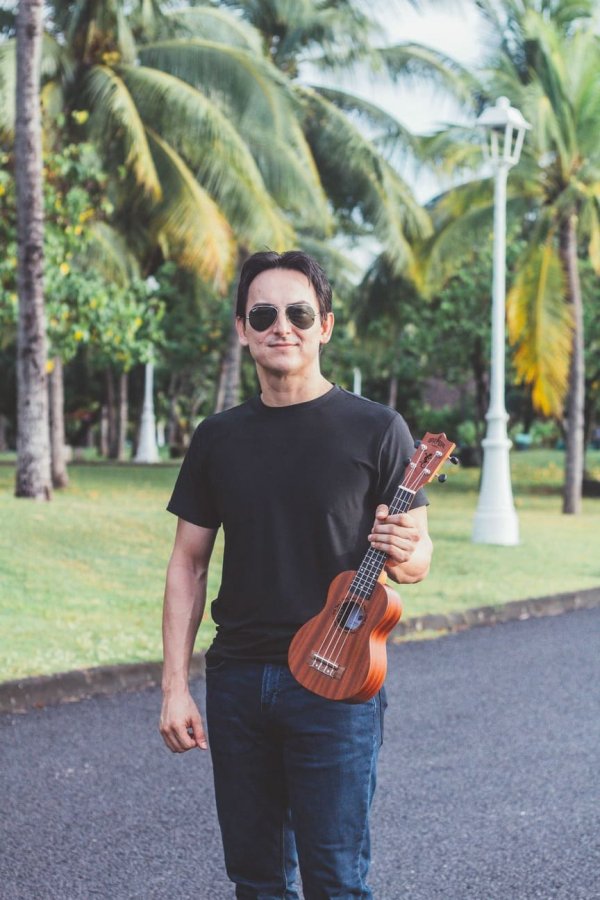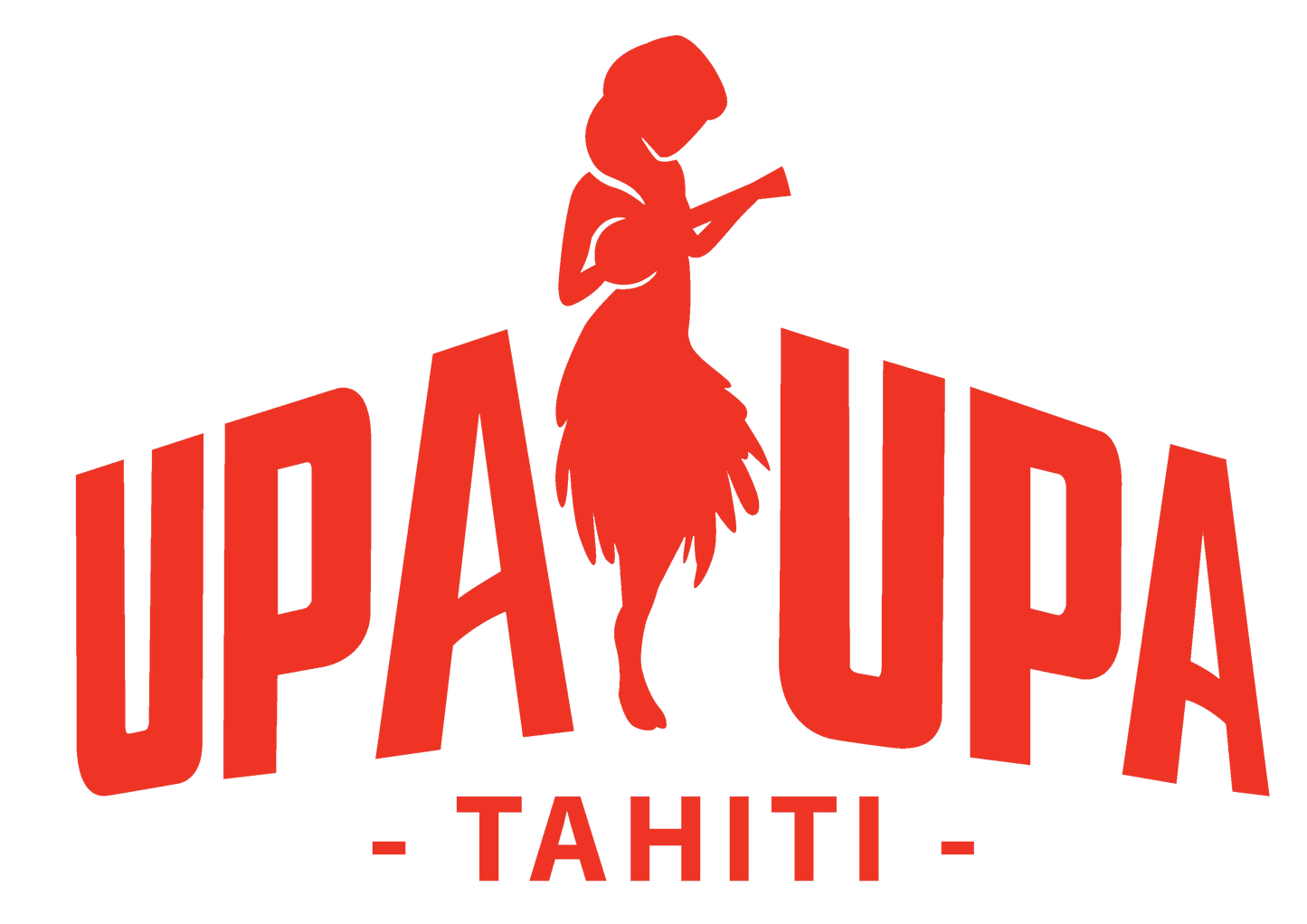
| favorite ukulele |
Ia ora na Florent! How was your attraction to music born?
Ia ora na! My father is also a musician so it came from a very young age, seeing ukuleles and guitars in the family home. I've always liked music: I've always been very curious, with this desire to explore, to go and see "where no one had gone". I was also greatly influenced by guitarists who were avant-garde, who never stopped pushing the limits of their instrument. Very young I felt that I wanted to do the same thing. So for music not to become something food, I chose to continue my studies, which allowed me to practice the profession that I do today, while having the luxury of being able to music that I like in my free time. I followed a traditional jazz / blues training where I learned improvisation and I evolve in a rock style mainly. Very early on I started playing in Hawaii, on the side of the United States. As a teenager, I went there regularly with my family. That's how I met people from the music industry, did live there and recorded my albums.
Can you tell us about “slide picking”, this electric guitar technique that you invented?
The principle is to strike a string with the pick and try to make sounds. The goal is to make loops, ringing the strings just by sliding the pick across the fingerboard. The left hand intervenes as little as possible.
It's a technique that I began to develop as a teenager, in the 95s. At the time, I wondered what I could do with this instrument that had never been done before. I was curious, it was really for fun! It was a bit of a crazy gamble, so for years it sat on hold. And in 2009, guitarist Michael Angelo Batio came to fenua several times. Listening to me play, he was surprised by this technique that he had never seen, although he traveled the world. It was he who encouraged me to share it on Youtube with the guitarist community. I had very good feedback, it represented a real interest for the community of musicians.
Today, it has come to the point where I can offer entire passages executed using this technique alone! Currently I am working on a new piece which this time will try to place this technique within the framework of an orchestration. The idea is to have bass, drums and make a real instrumental piece for 2,3,4 minutes on guitar using this technique.
You also had the opportunity to develop ukulele projects. How did it happen?
It was in 2012, when I was taking a musical break in order to devote myself fully to my doctoral thesis. At that time, a friend and producer from Hawaii offered me to do ukulele tracks for one of his albums because the instrument was coming back into fashion there… I like challenges so I answered favorably, saying to him “why not, I will try”. So I learned the ukulele “by default”, as I had no time to do anything else! But honestly, apart from the fact that there are strings and that I see roughly how to use them, I think like a guitarist. There were many things to learn: the tuning is different, the supports too… not to mention the technique! My references were not the same but I tried to use this instrument in the true sense of the term: like an “instrument”, allowing me to express myself according to what I manage to do. I also tried to take advantage of that, not knowing too much about the codes that really constitute the ukulele tradition. It may have allowed me, I hope, to introduce a new breath.
In 2014, the compilation was released under the name “Island style ukulele 2”, featuring many well-known Hawaiian artists. The idea was to offer ukulele re-interpretations of well-known rock songs. I proposed a revisited version of “Sweet City Woman” and it was this song that was chosen in high rotation in order to sell the album. The album won an award in Hawaii.
The same year, I also participated with my sister in a Christmas album which was nominated this time. Still on the ukulele, we reinterpreted the melody “Go Tell It On The Mountain”.
And then we reinterpreted traditional Hawaiian songs on the ukulele, sung in the Hawaiian language. It's still a great personal adventure because I chose the title “Hilo One” (Hilo which is a city on the island of Hawaii and “One” means “sand”, so it's the “Sand of Hilo ”). Although this song is a traditional title there, I knew it thanks to the group Hui Ohana who rocked my childhood. They came to Tahiti in 1987, John Gabilou had brought them, a friend of my father… I was 7 or 8 years old and it was the first concert I attended (by the way, I still have the ticket! ). It marked me because for me it is associated with so many things (my childhood, this music which rocked all these beautiful years spent in Hawaii with my parents…). So when it came to choosing a title for this project, I said to myself that symbolically there was something to play for. I didn't hesitate to reinvent the piece by composing parts that didn't exist in the original. One thing leading to another, the producer liked the version and it was this track that helped sell the album and win another Hoku Award (the Hawaiian equivalent of the Grammy Awards).
Personally I was really very happy because for all of these projects, it was not just covers that I proposed. Each time I really tried to reinvent the songs, having fun with all the musical tools I had at my disposal and according to what I was asked to do.
Thank you Florent for this exchange! And finally, do you have any future projects?
In recent years, I admit to being overwhelmed by the professional side. Recently I played again with my sister, we try to keep in touch with the public as best we can. We maintain the link in particular thanks to social networks. The idea is to redo a bigger concert very soon, an intermediate step before the release of a new album that I'm recording at home very slowly. Mauruuru Upa Upa Tahiti for this interview!
